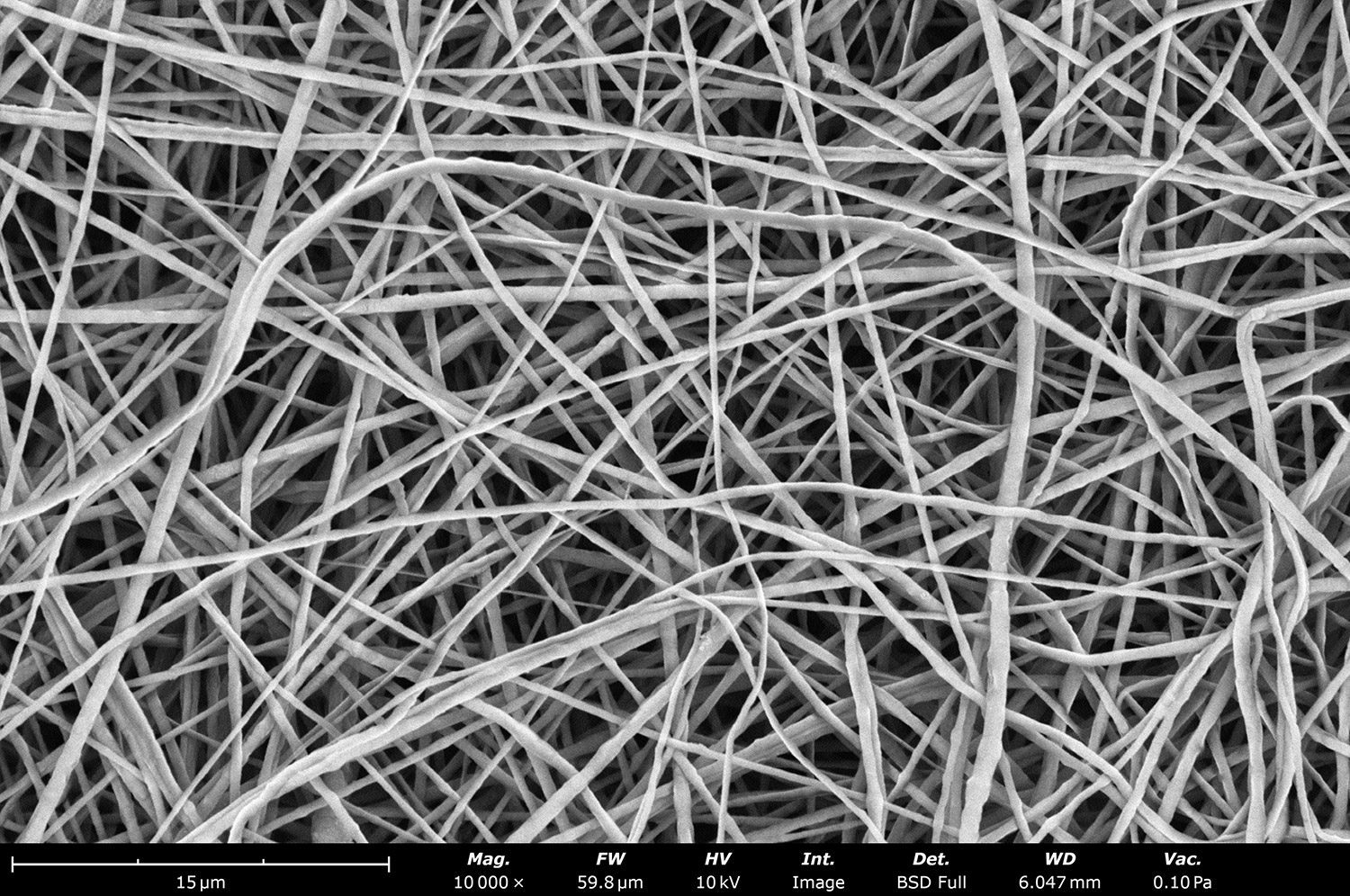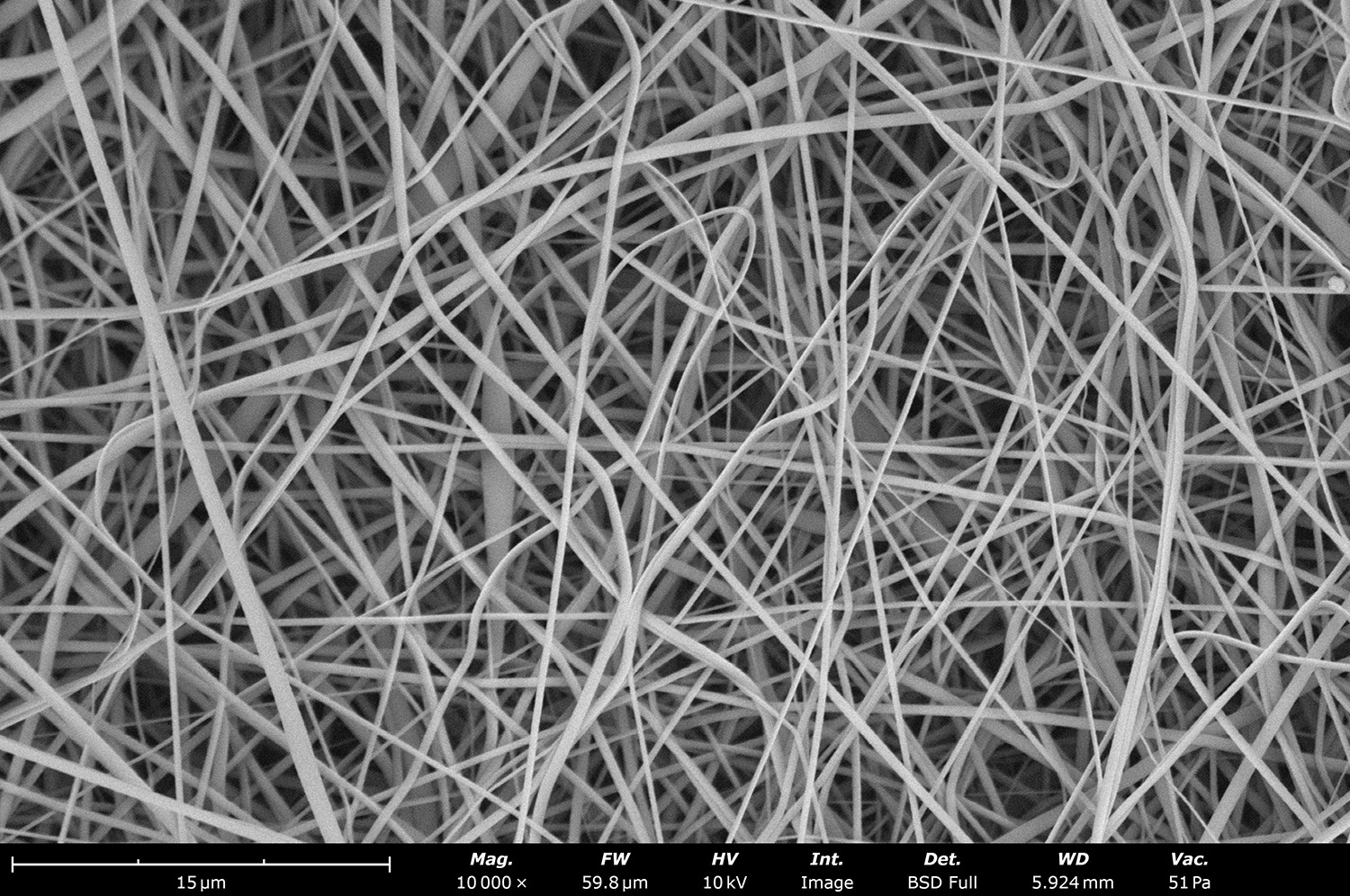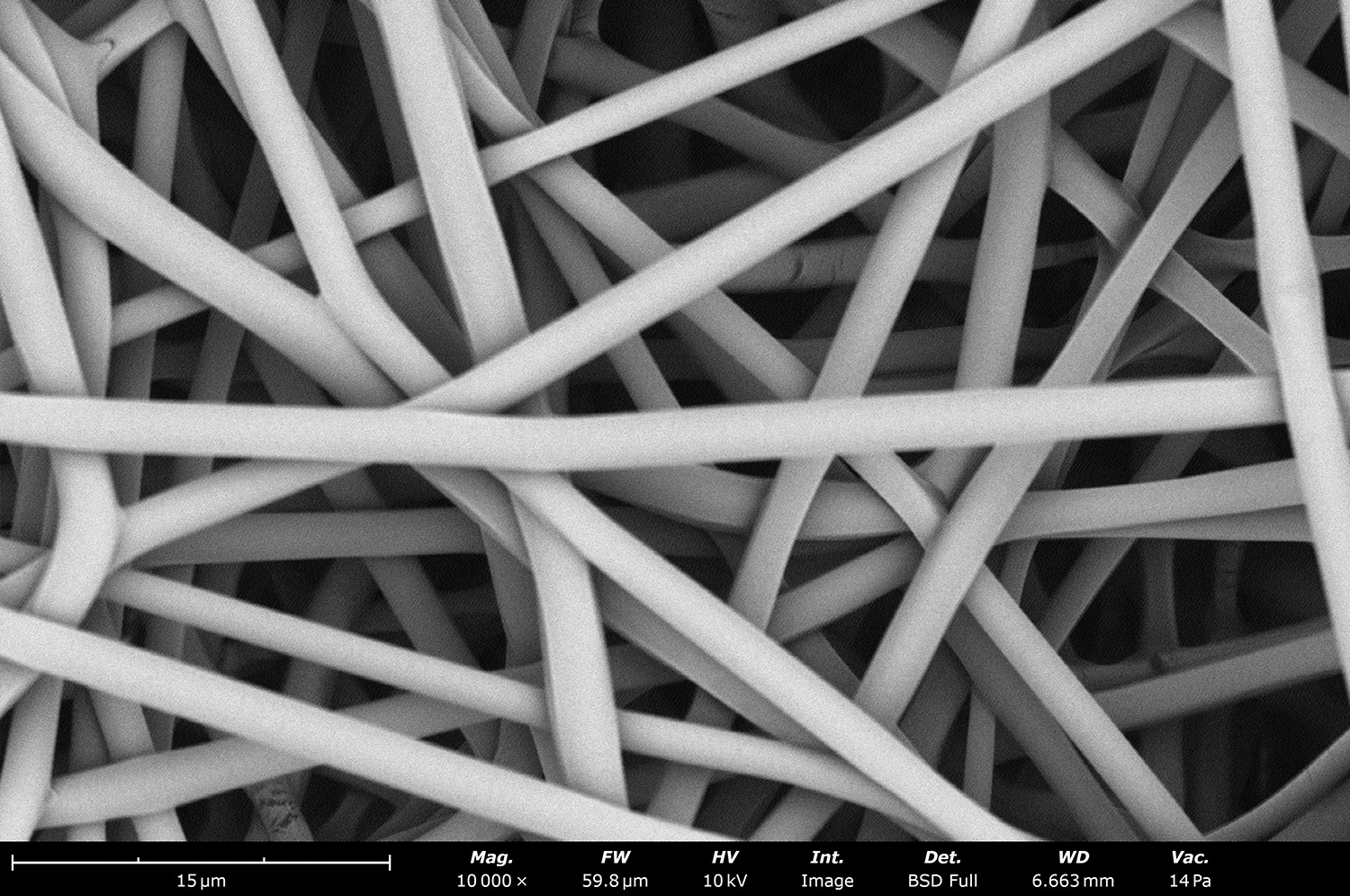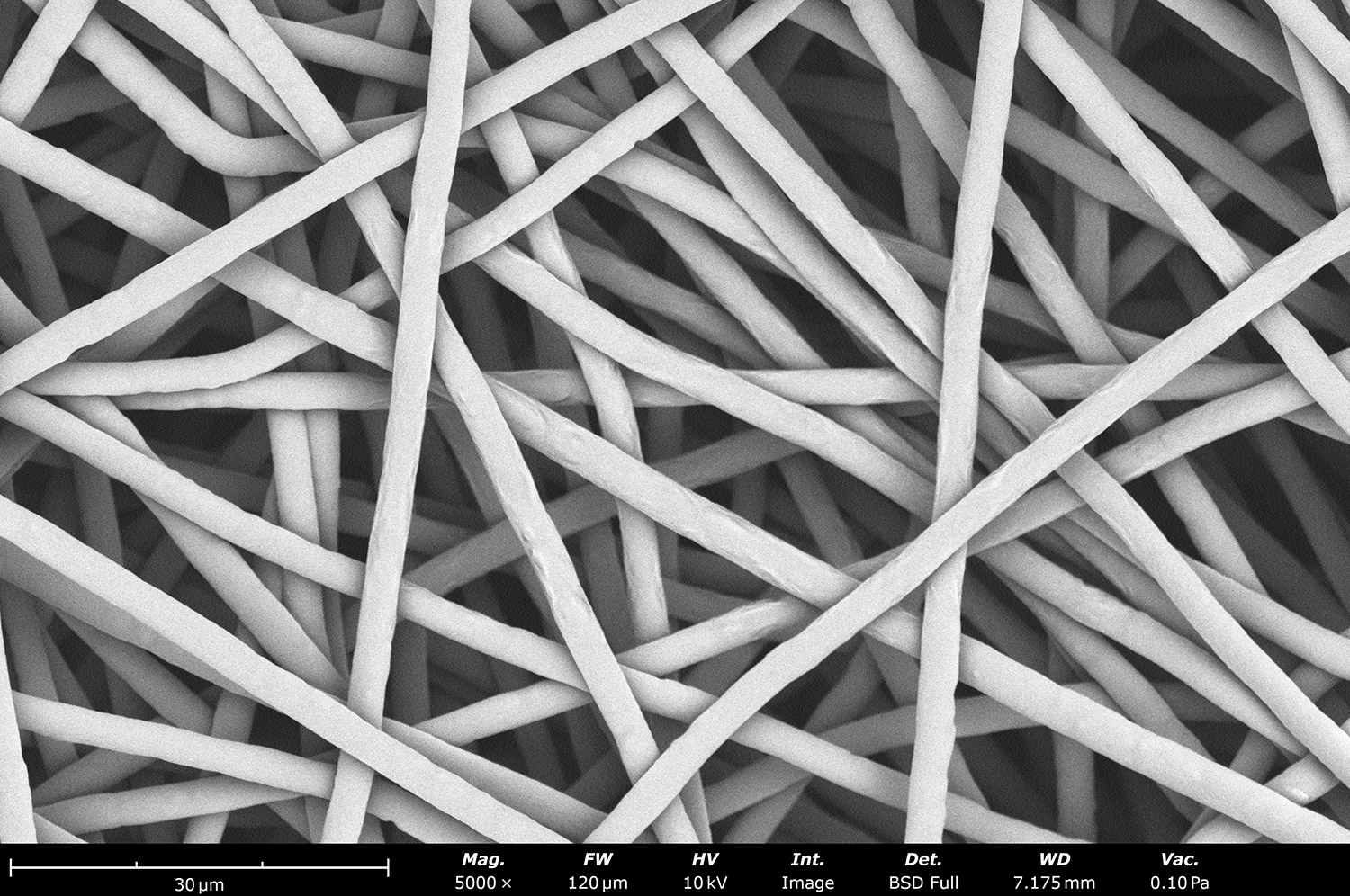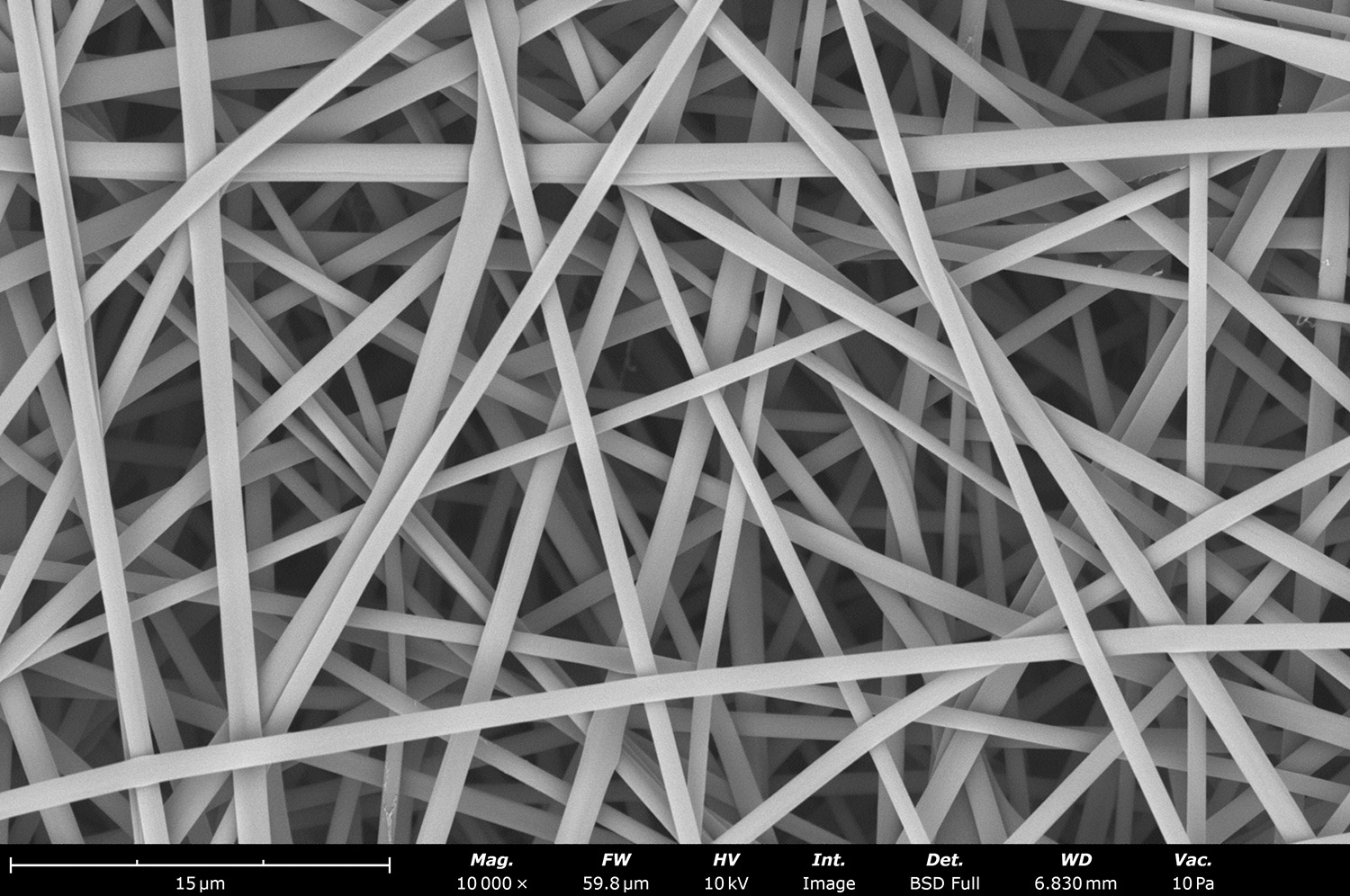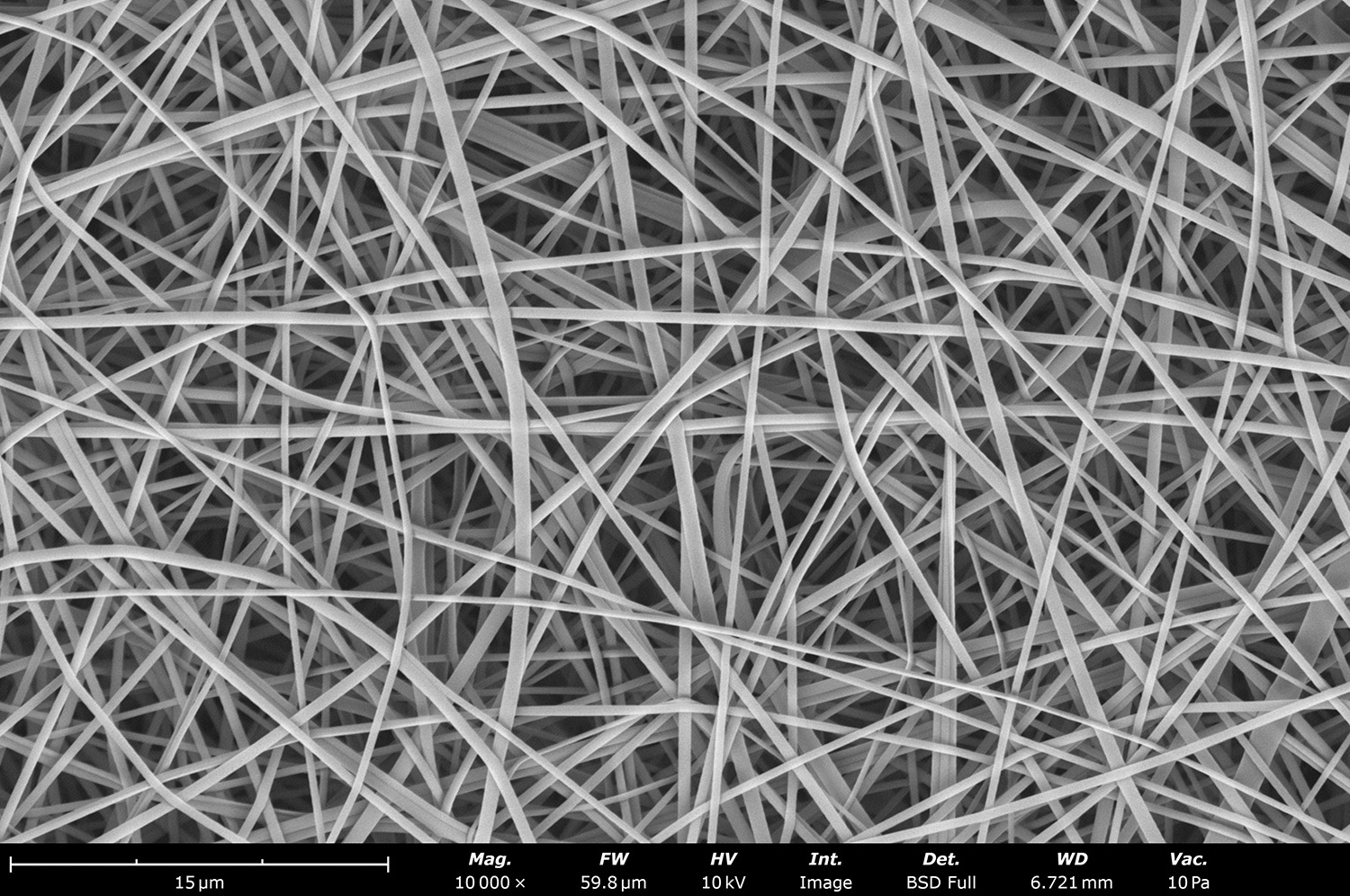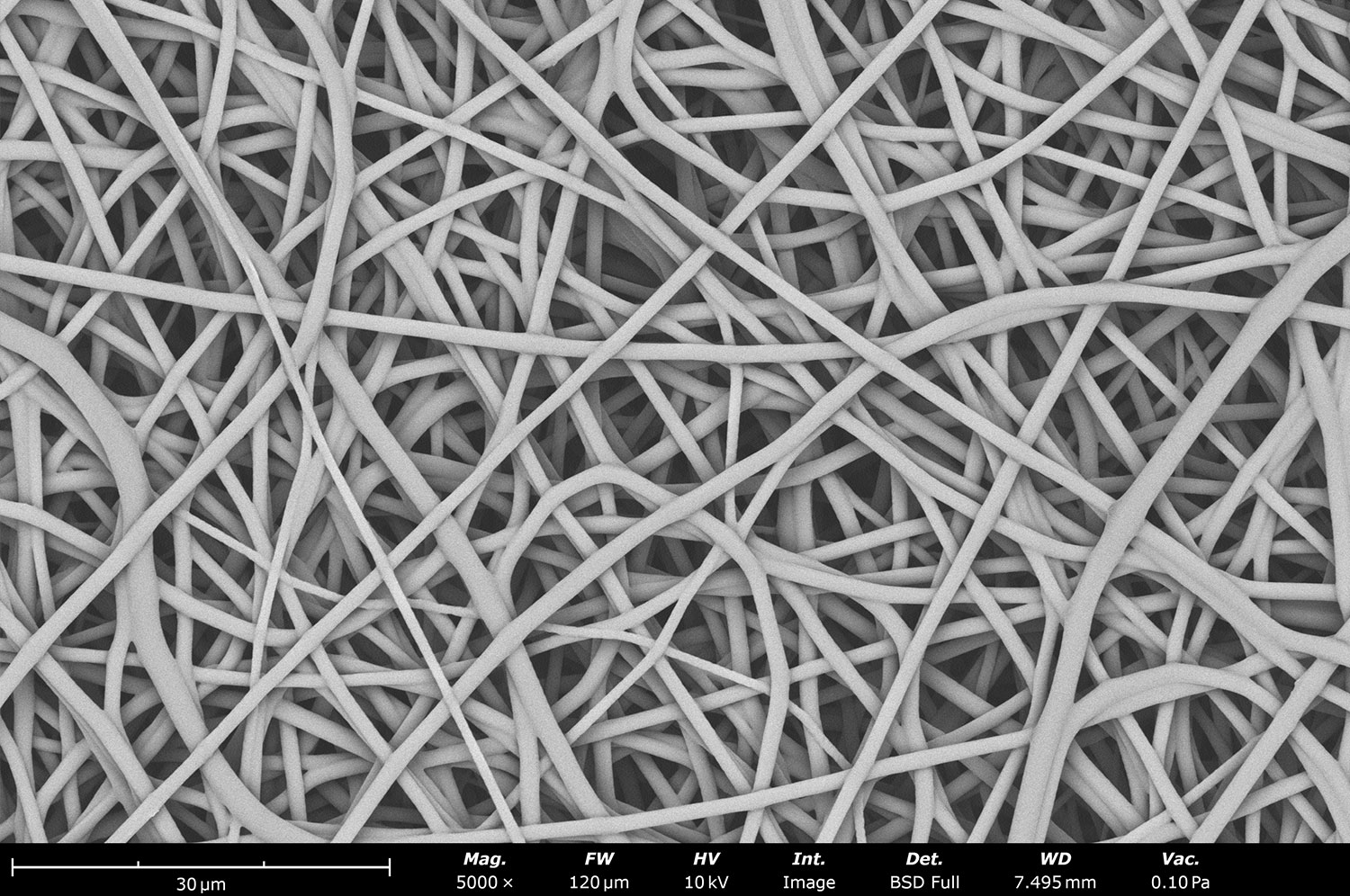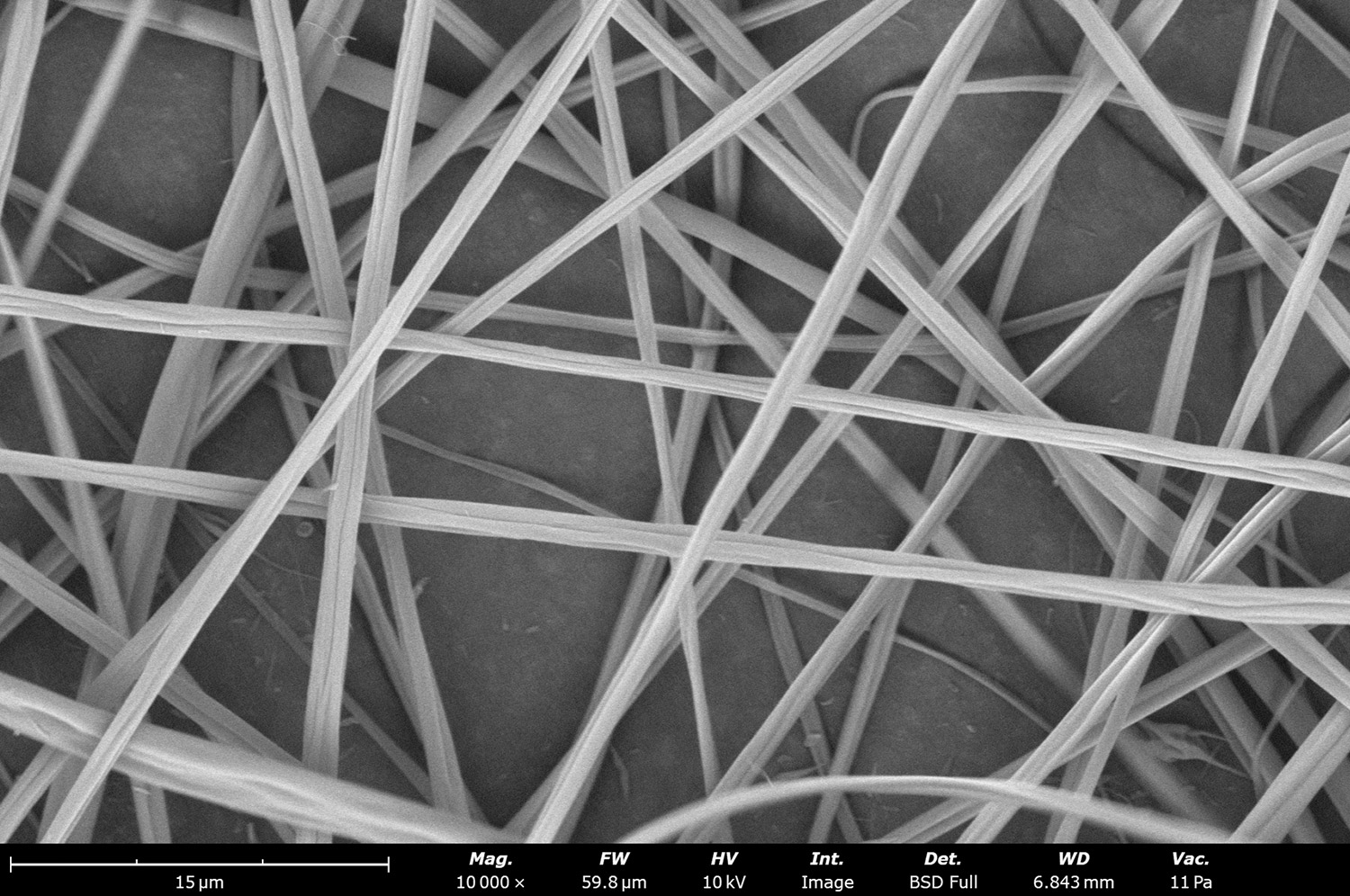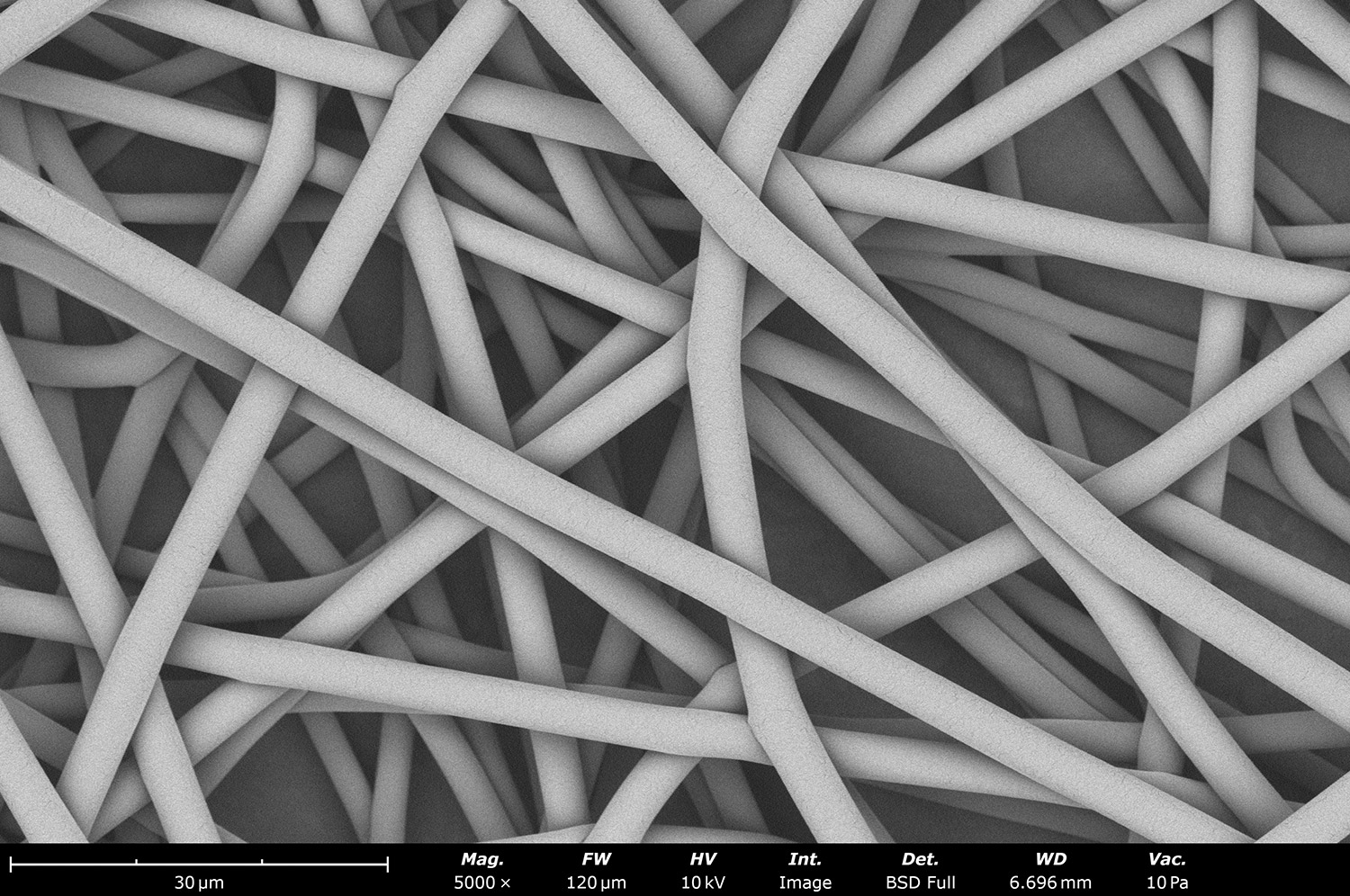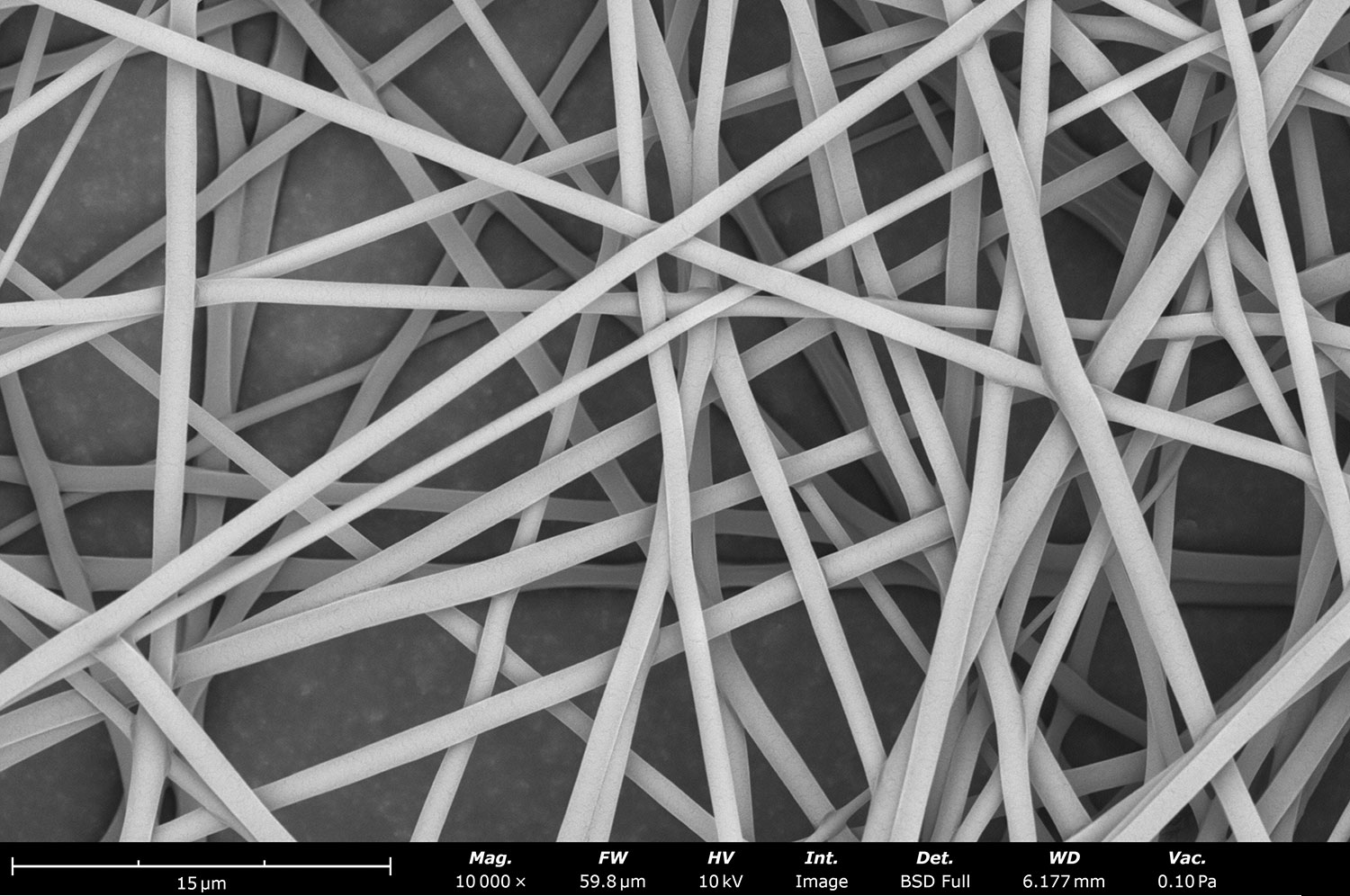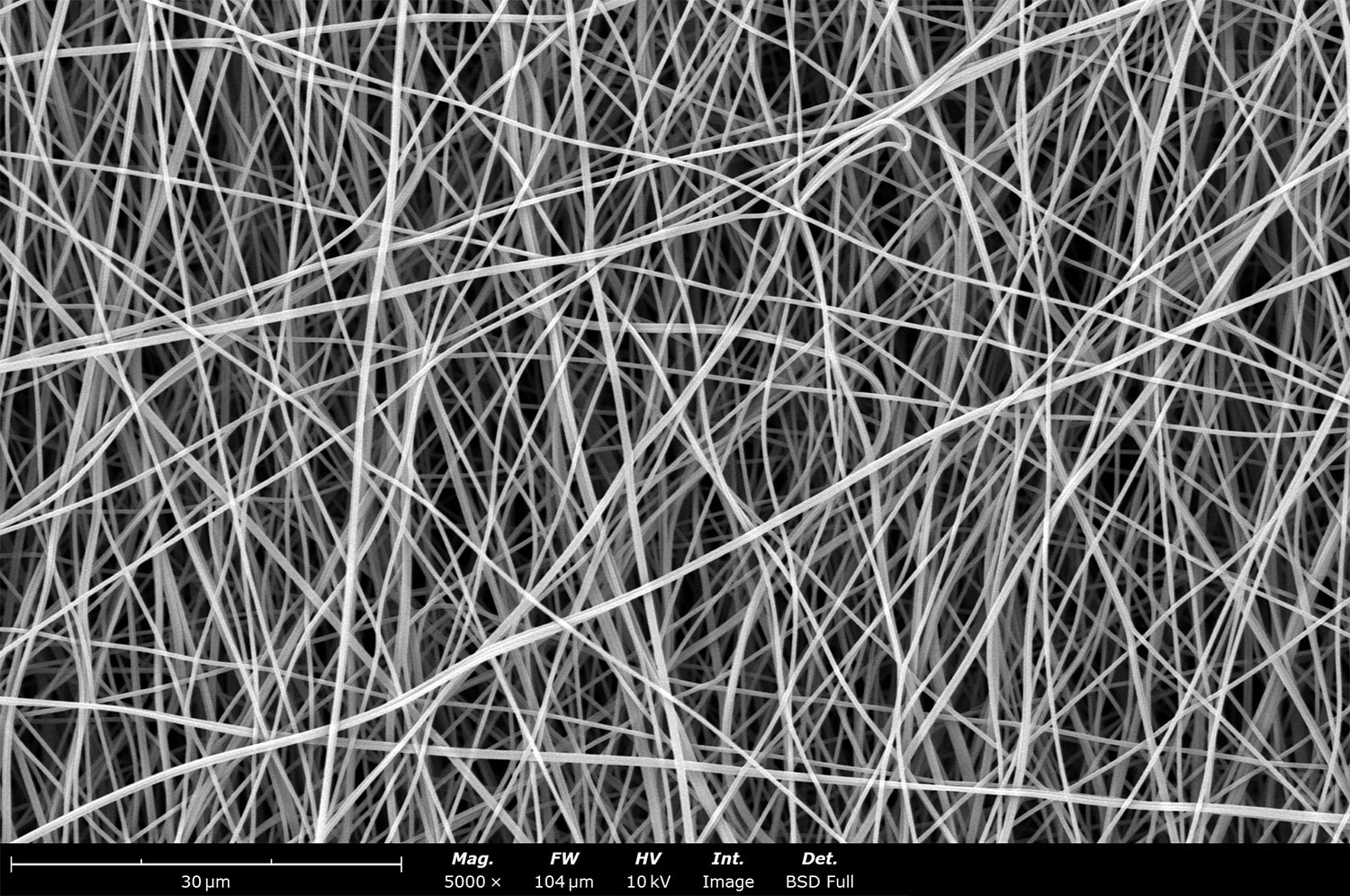Polymer Fiber Library
Espun Polymer Examples:
A wide variety of polymers can be electrospun to fabricate nanofibers, each offering distinct properties suitable for different applications. Natural polymers like collagen, gelatin, and chitosan are widely used in biomedical applications due to their biocompatibility and biodegradability, making them ideal for tissue engineering, wound healing, and drug delivery. Synthetic polymers such as polycaprolactone (PCL), polylactic acid (PLA), and polyvinyl alcohol (PVA) are frequently electrospun for use in areas like filtration, energy storage, and advanced textiles, offering durability, chemical resistance, and tunable mechanical properties. By adjusting the polymer choice and processing parameters, electrospun nanofibers can be tailored to meet specific performance requirements across industries.
A sampling of the different polymers that we have successfully electrospun is described below.
Polyethylene oxide (PEO)
PEO is a water-soluble, synthetic polymer that is commonly used in various fields due to its biocompatibility, low toxicity, and excellent solubility in aqueous solutions. PEO is non-toxic and biocompatible, making electrospun PEO fibers suitable for biomedical applications such as drug delivery systems, wound dressings, and tissue scaffolds. PEO is highly hydrophilic, leading to its use in filtration and moisture management applications. They can be used in creating advanced fabrics that are breathable and moisture-wicking. PEO’s water solubility allows for controlled release of encapsulated substances in pharmaceuticals and cosmetics.
Poly(vinylidene fluoride-co-hexafluoropropylene) (PVDF-HFP)
PVDF-HFP is a co-polymer known for its high chemical resistance, piezoelectric properties, and excellent mechanical and thermal stability. The chemical resistance, thermal stability, and fine porous structure of electrospun PVDF-HFP fibers make them ideal for filtration membranes in water treatment, air filtration, and chemical filtration systems. PVDF-HFP is commonly used in lithium-ion battery separators due to its electrochemical stability and porous structure, enhancing battery safety and performance.
PVDF-HFP has piezoelectric properties, which is highly desirable for sensors, actuators, and energy harvesting applications. Electrospun PVDF-HFP fibers are used in energy harvesting devices, such as flexible nanogenerators, which convert mechanical energy into electrical energy.
Polylactic acid (PLA)
PLA is a biodegradable, bio-based polymer derived from renewable resources like corn starch is a popular material in biomedical, environmental, and packaging applications. PLA is biodegradable, breaking down into non-toxic products like lactic acid. This property is particularly useful for environmentally friendly applications, such as biodegradable packaging and biomedical devices that degrade in the body. PLA is considered biocompatible, making it suitable for use in medical applications like tissue scaffolds, sutures, and drug delivery systems. Due to their fine structure and porosity, electrospun PLA fibers are used in air and water filtration systems. Their biodegradability is an added benefit for creating eco-friendly filtration products.
Polycaprolactone (PCL)
PCL is a biodegradable, semicrystalline polymer that is widely used in biomedical and tissue engineering applications due to its excellent biocompatibility and slow degradation rate. Polycaprolactone is known for its mechanical flexibility, easy processability, and compatibility with other polymers, which makes it a versatile material for electrospinning. PCL is biodegradable, breaking down slowly in physiological environments (via hydrolysis) into non-toxic byproducts making it particularly useful for long-term biomedical applications. PCL is biocompatible, meaning it is well tolerated by tissues and cells, making it suitable for use in drug delivery systems, scaffolds for tissue engineering, and wound dressings. Electrospun PCL fibers exhibit excellent flexibility and mechanical strength, making them suitable for load-bearing applications in tissue scaffolds or implants.
Gelatin
Gelatin is a natural biopolymer derived from collagen, a major component of the extracellular matrix, is widely used in biomedical applications because of its biocompatibility, biodegradability, and ability to mimic the extracellular matrix (ECM). Electrospinning gelatin results in nanofibers that have a high surface area and porosity, making them useful in tissue engineering, drug delivery and wound healing. It supports cell attachment, proliferation, and differentiation, which is essential for tissue engineering applications. Gelatin fibers can encapsulate and release drugs or bioactive molecules in a controlled manner. This makes them suitable for sustained drug delivery systems, where gradual degradation releases therapeutic agents over time. Gelatin is biocompatible and non-toxic, making it ideal for use in biomedical devices such as implants, stents, and surgical meshes.
Polyvinyl alcohol (PVA)
PVA is a synthetic polymer that is water-soluble, biodegradable, biocompatibility and non-toxic. It is commonly used in packaging, textiles, and medical applications. Electrospun PVA nanofibers are used as scaffolds for cell growth due to their biocompatibility and for advanced wound care as they promote healing while allowing controlled drug delivery. PVA nanofibers also have high surface area and small pore size making them ideal for air or liquid filtration. Biodegradable PVA fibers can also be used to develop eco-friendly packaging materials.
Thermoplastic Polyurethane (TPU)
TPU is a versatile polymer belonging to the thermoplastic elastomers (TPE) family. It combines the elasticity of rubber with the durability and processability of thermoplastics, offering a unique balance of properties. TPU is a block copolymer, typically made from three main components: the soft segments that provide the flexibility and elasticity, the hard segments that gives it the strength, rigidity, and resistance to deformation and the chain extender that adjust the mechanical properties of TPU allowing for fine-tuning of its flexibility, hardness, and durability.
Electrospun TPU nanofibers have found applications in like filtration, biomedical devices, and protective textiles. TPU nanofibers can be used as scaffolds for cell growth, tissue regeneration, or wound healing due to their elasticity and biocompatibility. TPU’s chemical resistance and durability make it useful in filters for air and liquid purification, especially where flexibility and wear resistance are needed. Certain formulations of TPU are used in medical implants due to their biocompatibility.
Cellulose Acetate
Cellulose acetate is a derivative of cellulose, a natural polymer found in plant cell walls and is widely used in various applications due to its biodegradability, biocompatibility, and versatility. Electrospinning cellulose acetate produces fine fibers that are useful in diverse fields including filtration, biomedical applications, and environmental protection. Electrospun cellulose acetate can be used in wound care due to its high surface area, porosity, and biocompatibility, promoting healing and providing a protective barrier. The fine fibers can trap particulate matter, pollutants, or microorganisms, making them effective for air and water filtration. The porous structure can be used to absorb oils and other hydrophobic substances from water.
Poly(L-lactide-ɛ-caprolactone) (PLCL)
PLCL is a biodegradable copolymer that combines the properties of poly(lactic acid) (PLA) and poly(ε-caprolactone) (PCL), offering a balance of rigidity and flexibility. The L-Lactide is a monomer derived from lactic acid, which contributes to the polymer’s rigidity and biodegradability. The ε-caprolactone is a monomer that provides flexibility and enhances the polymer’s ductility and degradation rate. PLCL nanofibers can be used as scaffolds for cell growth and tissue regeneration due to their biocompatibility and controlled degradation rates.
PLCL fibers can be used to create systems for controlled drug release, leveraging their porous structure and ability to incorporate drugs. Due to their biodegradability and mechanical properties, PLCL fibers can be used in temporary orthopedic implants or supports that degrade over time as new tissue forms.
Polyglycolic acid
PGA is a linear aliphatic polyester made from the polymerization of glycolic acid monomers. PGA is a biodegradable and biocompatible polymer, commonly used in biomedical applications. The porous structure and biocompatibility of PGA fibers make them suitable for controlled drug release systems. PGA’s high surface area and biocompatibility make it suitable for use in wound care products, where it can promote healing and provide a protective barrier. PGA is commonly used in the production of absorbable surgical sutures due to its strength and biodegradability. PGA can be blended with other polymers to tailor its properties, such as combining it with PLA for a balance of strength and degradation rate.
Polyacrylonitrile (PAN)
PAN is a synthetic polymer, made from the polymerization of acrylonitrile monomers, known for its high strength, thermal stability, and chemical resistance. Electrospinning PAN produces nanofibers with a variety of applications, particularly in fields like filtration, energy storage, and textiles. PAN has high tensile strength and rigidity, maintains its properties at high temperatures and is resistant to many chemicals, including solvents and acids.
PAN fibers can be used as electrodes in supercapacitors due to their high surface area and conductivity, especially after carbonization. The high surface area and fine pore structure of electrospun PAN fibers make them effective for trapping particulate matter and pollutants. The biocompatibility and high surface area of PAN fibers can be beneficial for advanced wound care products and to be used as scaffolds to support cell growth and tissue regeneration. PAN is commonly used as a precursor in the production of carbon fibers due to its high carbon content and excellent mechanical properties.
Examples of Electrospun Polymers & Applications:
| Polymer | Solvents | Fiber diameter (nm) | Applications |
|---|---|---|---|
| Polyethylene oxide (PEO) | Water, Water/Alcohol blends | 200-700 nm | Drug Encapsulation cosmetics |
| Poly(vinylidene fluoride-co-hexafluoropropylene) (PVDF-HFP) | Acetone/DMF, N,N,Dimethylacetamide | 200 – 1000 nm | Vascular grafts, Stent coating, Battery separators. |
| Polylactic acid (PLA) | HFIP, DCM/DMF, THF/DMF, Acetone | 200 – 2000 nm | Drug delivery, wound healing, vascular grafts, Filtration |
| Polycaprolactone (PCL) | HFIP, DCM/DMF, THF/DMF, Acetic Acid, Formic Acid, chloroform | 300 – 3000 nm | Tissue scaffolds |
| Gelatin | HFIP/Acetic acid, Acetic acid, Formic Acid | 100-1000 nm | Tissue scaffolds |
| Polyvinyl alcohol (PVA) | Water | 200-600 nm | Drug delivery |
| Thermoplastic Polyurethane (TPU) | DMF, DMAC, THF | 200-1000 nm | Vascular stents |
| Cellulose Acetate | Acetone, THF, Methyl acetate | 100-1000 nm | Wound healing, Drug delivery, |
| Poly(L-lactide-ɛ-caprolactone) (PLCL) | HFIP, DCM, Chloroform | 500-4000 nm | Drug delivery, Tissue engineering |
| Polyglycolic acid | HFIP | 500-2000 nm | Wound healing |
| Polyacrylonitrile (PAN) | DMF, DMSO | 200-4000 nm | Implants, Energy |
| Polyacrylonitrile (PAN) with loaded TiO2 nanoparticles | DMF, DMSO | 200-1000 nm | UV protection, Antimicrobial |
Contact Us
We are a multi-disciplinary laboratory committed to providing our expertise and efficient analytical services.

